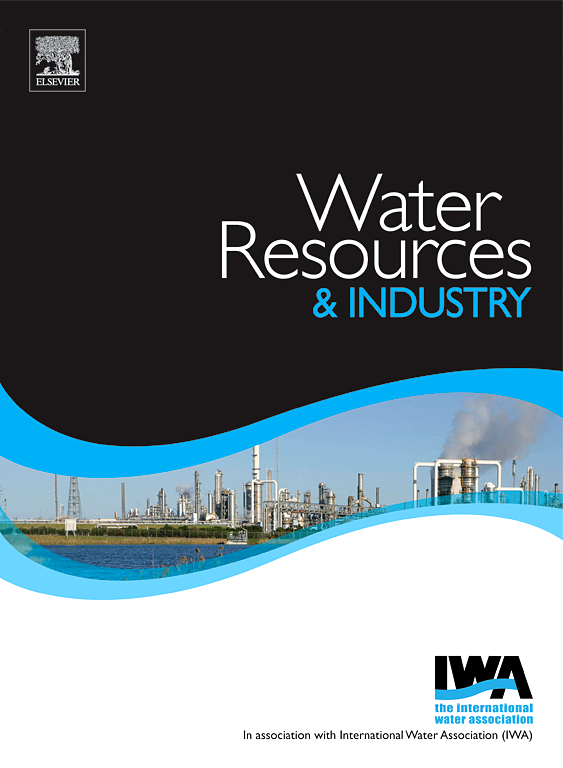研究了氧化石墨烯复合Fe-MIL-88(A)催化剂处理纺织废水的电fenton法
IF 4.5
3区 工程技术
Q1 WATER RESOURCES
引用次数: 0
摘要
纺织行业是最复杂的行业之一,由于其染料的高毒性和不可生物降解性而存在重大问题。该行业的污染物对生物和环境构成威胁,因此对其进行净化具有重要意义。近年来,深度氧化法(AOPs)比其他方法更有效地处理该废水。因此,本研究的重点是利用电fenton法合成MIL-88A(Fe)/rGO去除纺织废水中的有机物。首先采用水热法合成MIL-88A(A)纳米棒,并将其嵌入氧化石墨烯(GO)衬底中。然后,通过光谱和显微技术对合成的复合材料进行了检测,所有分析都表明MIL-88A(Fe)/rGO结构正确形成。在每个实验中,电流密度的值和电极之间的距离分别为9 Am−2和1 cm。采用响应面法(RSM)对pH、时间、MIL-88A(Fe)/rGO复合材料用量、Na2S2O8氧化剂浓度等参数进行优化。试验的最佳条件为pH为5,持续时间为60 min, MIL-88A(Fe)/rGO复合浓度为0.61 g/L,氧化剂浓度为0.017 m。根据所得到的最优值,对纺织厂废水的COD去除率在统计上和实验上分别为76.5%和78%。电fenton工艺的结果表明,具有环保钛和石墨电极的MIL-88A(Fe)/rGO复合材料具有良好的效率,在加速净化过程方面超越了先前的研究。本文章由计算机程序翻译,如有差异,请以英文原文为准。
Investigating textile wastewater treatment by electro-Fenton method with Fe-MIL-88(A) catalyst composited with graphene oxide
The textile sector is one of the most complex industries that has significant problems due to the high toxicity and non-biodegradable properties of its dyes. Pollutants in this industry are a threat to living organisms and the environment, so their purification is of great importance. Recently, advanced oxidation processes (AOPs) have been more effective than other methods of treating this wastewater. Therefore, the focus of this study is on the synthesis of MIL-88A(Fe)/rGO for the removal of organic substances from textile wastewater using the electro-Fenton method.
MIL-88(A) nanorods were first synthesized by hydrothermal method and embedded in graphene oxide (GO) substrate. Then, the synthesized composite was examined through spectroscopic and microscopic techniques, all analyses showed the correct formation of MIL-88A(Fe)/rGO structure. In each experiment, the value of the current density and the distance of the electrodes were considered equal to 9 Am−2 and 1 cm, respectively. The response surface method (RSM) was utilized to optimize parameters such as pH, time, the quantity of MIL-88A(Fe)/rGO composite, and the concentration of Na2S2O8 oxidant. The optimal conditions for conducting the test are pH 5, duration of 60 minutes, MIL-88A(Fe)/rGO composite concentration of 0.61 g/L, and oxidizer concentration of 0.017 M. According to the obtained optimal values, COD removal efficiency from textile factory wastewater is statistically and experimentally equal to 76.5 % and 78 %, respectively. The results of the electro-Fenton process demonstrated the promising efficiency of the MIL-88A(Fe)/rGO composite with environmentally friendly titanium and graphite electrodes, surpassing previous studies in accelerating the purification process.
求助全文
通过发布文献求助,成功后即可免费获取论文全文。
去求助
来源期刊

Water Resources and Industry
Social Sciences-Geography, Planning and Development
CiteScore
8.10
自引率
5.90%
发文量
23
审稿时长
75 days
期刊介绍:
Water Resources and Industry moves research to innovation by focusing on the role industry plays in the exploitation, management and treatment of water resources. Different industries use radically different water resources in their production processes, while they produce, treat and dispose a wide variety of wastewater qualities. Depending on the geographical location of the facilities, the impact on the local resources will vary, pre-empting the applicability of one single approach. The aims and scope of the journal include: -Industrial water footprint assessment - an evaluation of tools and methodologies -What constitutes good corporate governance and policy and how to evaluate water-related risk -What constitutes good stakeholder collaboration and engagement -New technologies enabling companies to better manage water resources -Integration of water and energy and of water treatment and production processes in industry
 求助内容:
求助内容: 应助结果提醒方式:
应助结果提醒方式:


